instrument panel AUDI A5 2015 Owner´s Manual
[x] Cancel search | Manufacturer: AUDI, Model Year: 2015, Model line: A5, Model: AUDI A5 2015Pages: 264, PDF Size: 66.83 MB
Page 56 of 264
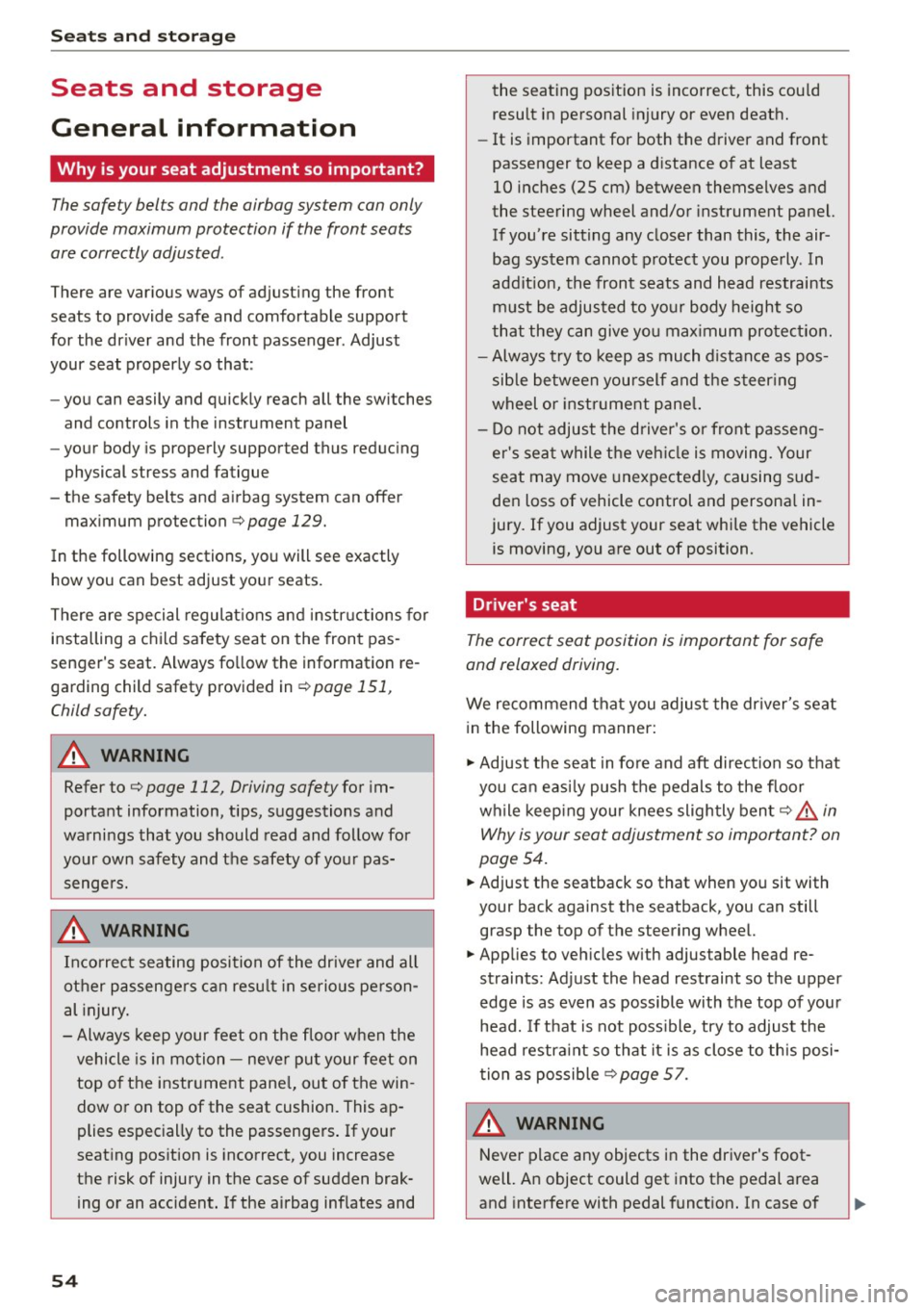
Seat s and storage
Seats and storage
General information
Why is your seat adjustment so important?
The safety belts and the airbag system can only
provide maximum protection if the front seats are correctly adjusted .
There are various ways of adjusting the front
seats to provide safe and comfortable support
for the dr iver and the front passenger . Adjust
your seat properly so that :
- you can easily and quickly reach all the switches
and controls in the instrument panel
- your body is properly supported thus reducing
physical stress and fatigue
- the safety belts and a irbag system can offer
maximum protection
¢ page 129.
In the following sections, you will see exactly
how you can best adjust your seats.
There are special regulat ions and instructions for
installing a child safety seat on the front pas
senger's seat . Always fo llow the information re
garding child safety provided in¢
page 151 ,
Child safety.
_&. WARNING
Refer to¢ page 112, Driving safety for im
portant information, tips, suggestions and
warnings that you should read and follow for
your own safety and the safety of your pas
senge rs.
_&. WARNING
Incorrect seating position of the driver and all
other passengers can resu lt in serious person
al injury.
- Always keep your feet on the floor when the
vehicle is in motion -neve r put your feet on
top of the instr ument pane l, out of the win
dow or on top of the seat cushion. This ap
plies espec ially to the passengers . If your
seat ing position is incorrect, you increase
the risk of injury in the case of sudden brak ing or an accident. If the airbag inflates and
54
the seating position is incorrect, this cou ld
result in personal injury or even death.
- It is important for both the driver and front
passenger to keep a distance of at least
10 inches (25 cm) between themselves and
the steering wheel and/or instrument panel.
If you're sitting any closer than this, the air
bag system cannot protect you properly . In
addition, the front seats and head restraints
must be adjusted to your body height so
that they can give you max imum protect ion.
- Always try to keep as much distance as pos sible between yourself and the steer ing
wheel or instrument pane l.
- Do not adjust the driver's or front passeng
er 's seat while the vehicle is moving. Your
seat may move unexpected ly, causing sud
den loss of vehicle control and persona l in
jury.
If you adjust your seat while the vehicle
is moving, you are out of position.
Driver's seat '
The correct seat position is important for safe
and relaxed driving.
We recommend that you adjust the dr iver's seat
in the following manner:
~ Adjust the seat in fore and aft direction so that
you can easi ly push the pedals to the floor
while keepi ng your knees slightly bent¢ .&,
in
Why is your seat adjustment so important? on
page 54.
~ Adjust the seatback so that when you sit with
your back against the seatback, you can still
grasp the top of the steering wheel.
~ Applies to veh icles with adjustable head re
straints: Adjust the head restraint so the upper
edge is as even as possible with the top of your
head.
If that is not poss ible, try to adjust the
head restra int so that it is as close to this posi
tion as possible ¢
page 57.
_&. WARNING
Never place any objects in the driver's foot
well. An object could get into the pedal area
and interfere with pedal funct ion. In case of
-
Page 62 of 264
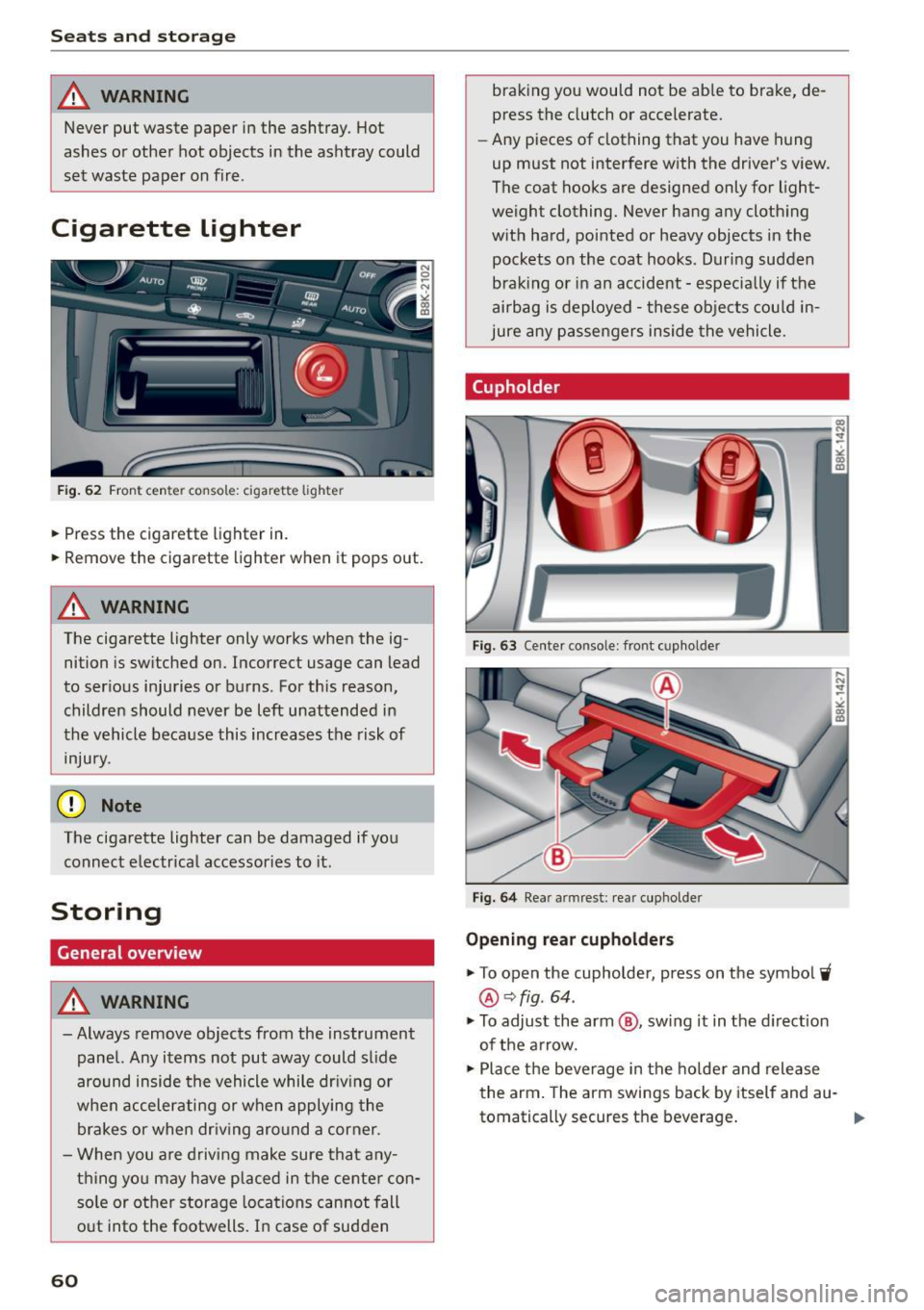
Seats and storag e
_& WARNING
Never put waste paper in the ashtray . Hot
ashes or other hot objects in the ashtray could
set waste paper on fire .
Cigarette Lighter
Fig. 62 Fron t center c onso le: cig arett e lighter
.,. Press the c igarette lighter in .
.,. Remove the cigarette lighter when it pops out .
_& WARNING
The cigarette lighter only works when the ig
nition is sw itched on. Incorrect usage can lead
to ser ious injuries or burns. For this reason,
children should never be left unattended in
the vehicle because this increases the risk of
injury.
(D Note
The ciga rette lighter can be damaged if you
connect electrical accessories to it .
Storing
General overview
_& WARNING
- Always remove objects from the instrument
panel. Any items not put away could slide
around inside the vehicle while dr iv ing or
when accelerating or when applying the brakes or when dr iv ing aro und a corner .
- When you a re driv ing make sure that a ny
thing yo u may have placed in the ce nter con
so le or ot her storage locations can not fall
o ut into the footwells. In case of sudden
60
braking you would not be ab le to brake, de
press the clutch or accelerate.
- Any pieces of clothing that you have hung
up must not interfere with the driver's view .
The coat hooks are designed only for light
weigh t clothing. Never hang any cloth ing
w ith ha rd, pointed or heavy objects in the
pockets on the coat hooks. During sudden
braking or in an accident -espec ially if the
airbag is deployed -these objects cou ld in
jure any p assengers inside the vehicle.
Cupholder
F ig. 63 Center co nsole: front cup holde r
Fig. 6 4 Rea r arm rest: rear cuphol der
Opening re ar cupholders
.,. To open the cupholder, press on the symbol~
®Qfig . 64 .
.,. To adjust the arm @, sw ing it in the d irection
of the a rrow.
.,. Place the beverage in the ho lder and release
the arm . The arm sw ings back by itself and au-
tomatically secures the beverage .
Ill>-
Page 63 of 264
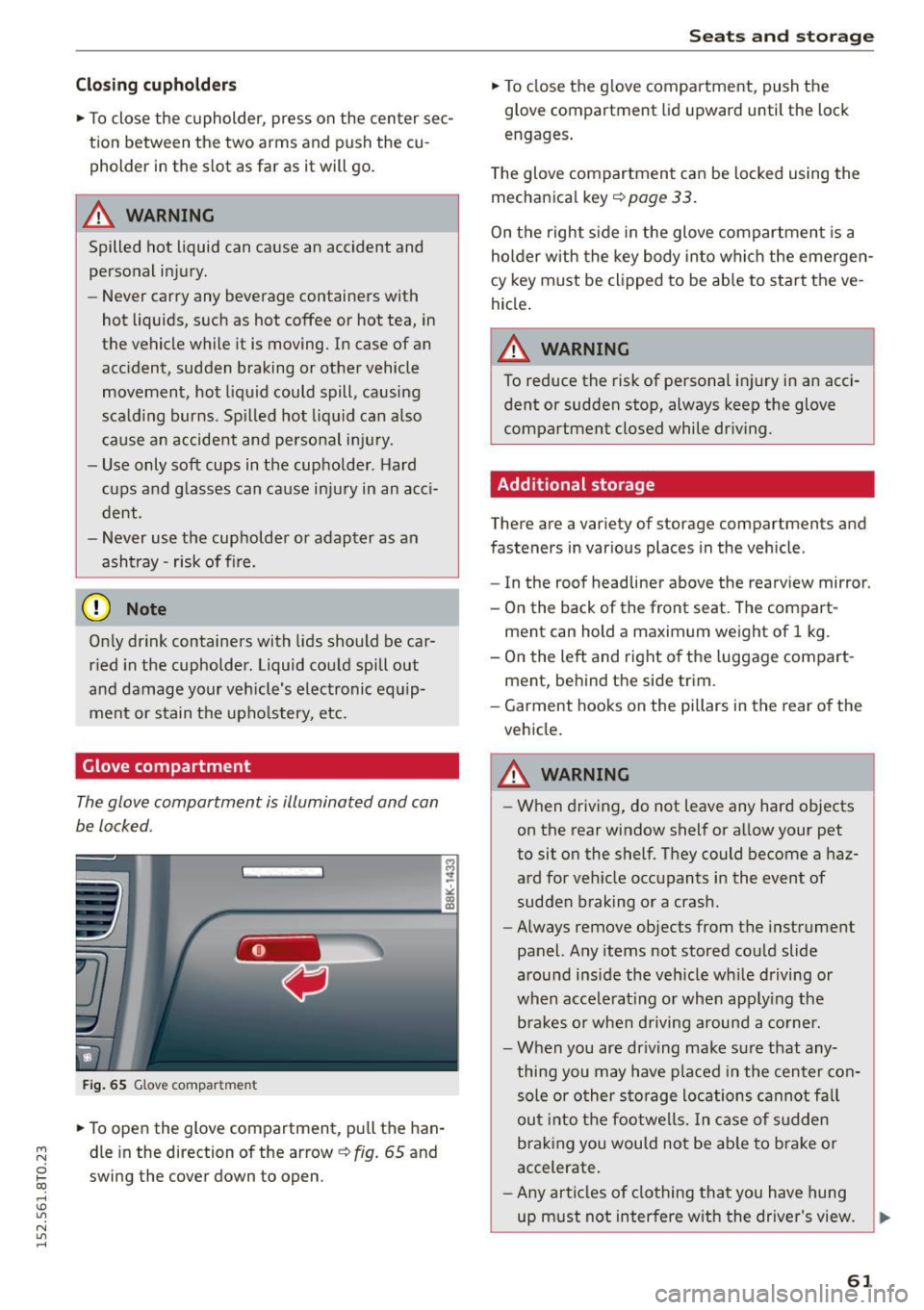
M N
0 loo
rl I.O
"' N
"' rl
Closing cupholders
• To close the cupholder, press on the center sec
tion between the two arms and push the cu
pholder in the slot as far as it will go.
.&_ WARNING
Spilled hot liquid can cause an accident and
personal injury.
- Never carry any beverage containers with
hot liquids, such as hot coffee or hot tea, in
the vehicle while it is moving. In case of an
accident, sudden braking or other vehicle
movement, hot liquid could spill, causing
scalding burns . Spil led hot liquid can also
cause an accident and personal injury.
- Use only soft cups in the cupholder. Hard
cups and glasses can cause injury in an acci
dent .
- Never use the cupholder or adapter as an
ashtray - risk of fire.
(y Note
Only drink containers with lids should be car
r ied in the cupholder . Liquid could spill out
and damage your vehicle's electronic equip
ment or stain the upholstery, etc.
Glove compartment
The glove compartment is illuminated and can
be locked .
Fig. 65 Glove compar tmen t
• To open the glove compartment, pull the han
dle in the direction of the arrow~
fig. 65 and
swing the cover down to open .
Seats and storage
• To close the glove compartment, push the
glove compartment lid upward until the lock
engages .
The glove compartment can be locked using the
mechanical key
~ page 33 .
On the right side in the glove compartment is a
holder with the key body into which the emergen
cy key must be clipped to be able to start the ve
hicle.
A WARNING
-
To reduce the risk of personal injury in an acci-
dent or sudden stop, always keep the glove
compartment closed while driving.
Additional storage
There are a variety of storage compartments and
fasteners in various places in the vehicle .
- In the roof headliner above the rearview mirror.
- On the back of the front seat . The compart -
ment can hold a maximum weight of 1 kg.
- On the left and right of the luggage compart
ment, behind the side trim .
- Garment hooks on the pillars in the rear of the
vehicle.
A WARNING ,..___
- When driving, do not leave any hard objects
on the rear window shelf or allow your pet
to sit on the shelf. They could become a haz
ard for vehicle occupants in the event of
sudden braking or a crash .
- Always remove objects from the instrument
panel. Any items not stored could slide
around inside the vehicle whi le driving or
when accelerating or when apply ing the
b rakes or when driving around a corner.
- When you are driving make sure that any
thing you may have placed in the center con
sole or other storage locations cannot fall
out into the footwells. In case of sudden
braking you would not be able to brake or
accelerate.
- Any articles of clothing that you have hung
up must not interfere with the driver's view .
~
61
Page 116 of 264
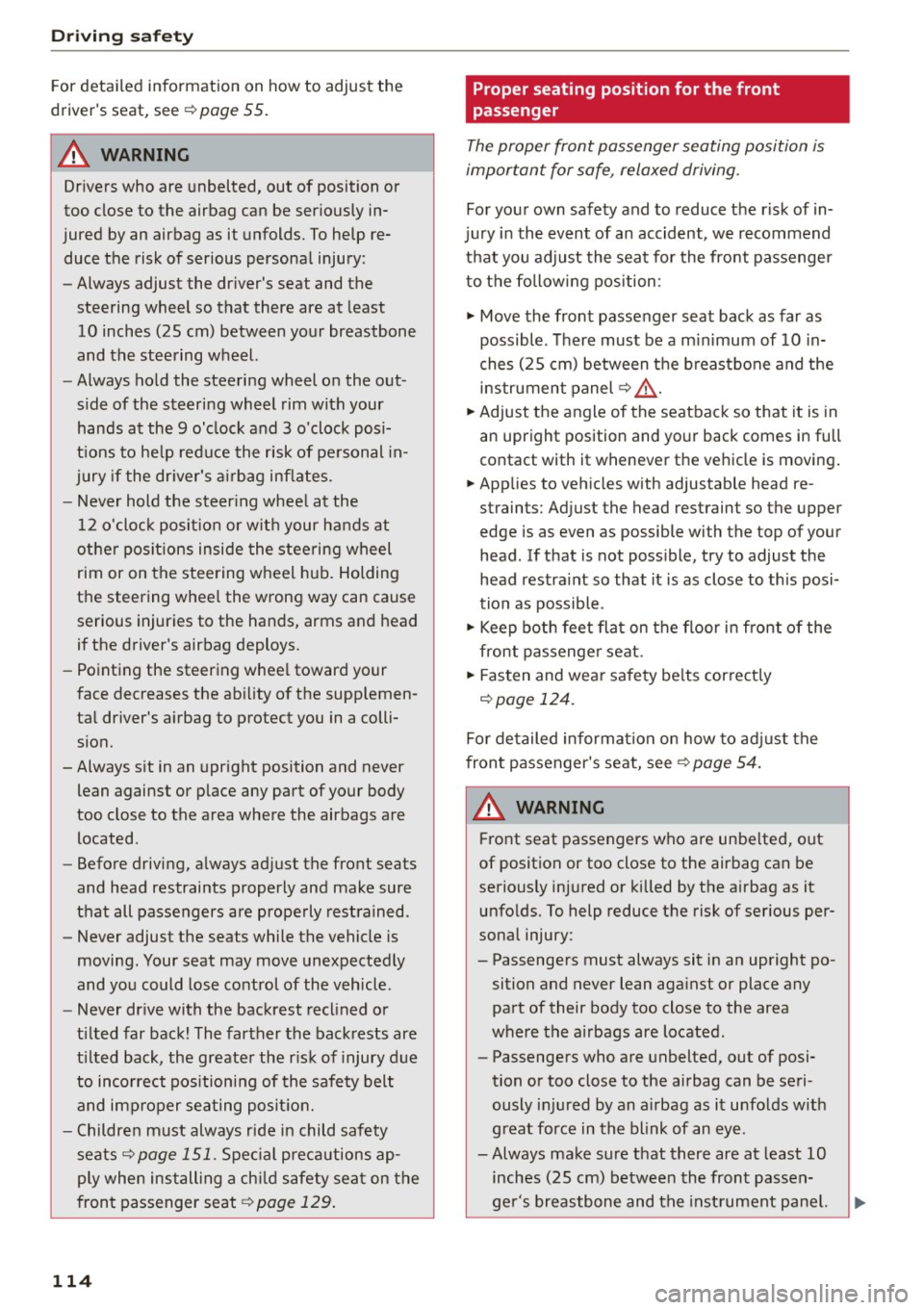
Driving safety
For detailed information on how to adjust the
driver's seat, see
¢ page 55.
A WARNING
Drivers who are unbelted, out of position or
too close to the airbag can be seriously in
jured by an airbag as it unfolds. To help re duce the risk of serious personal injury:
- Always adjust the driver's seat and the
steering wheel so that there are at least
10 inches (25 cm) between your breastbone
and the steering wheel.
- Always hold the steering wheel on the out
side of the steering wheel rim with your
hands at the 9 o'clock and 3 o'clock posi
tions to help reduce the risk of personal in
jury if the driver's airbag inflates .
- Never hold the steering wheel at the
12 o'clock position or with your hands at
other positions inside the steering wheel
rim or on the steering wheel hub . Holding
the steering wheel the wrong way can cause
serious injuries to the hands, arms and head
if the driver's airbag deploys.
- Pointing the steering wheel toward your
face decreases the ability of the supplemen
tal driver's airbag to protect you in a colli
sion.
- Always sit in an upright position and never
lean against or place any part of your body
too close to the area where the airbags are located .
- Before driving, always adjust the front seats
and head restraints properly and make sure
that all passengers are properly restrained.
- Never adjust the seats while the vehicle is
moving . Your seat may move unexpectedly
and you could lose control of the vehicle.
- Never drive with the backrest reclined or
tilted far back! The farther the backrests are
tilted back, the greater the risk of injury due
to incorrect positioning of the safety belt and improper seating position.
- Children must always ride in child safety
seats
¢page 151. Special precautions ap
ply when installing a child safety seat on the
front passenger seat¢
page 129 .
114
-
Proper seating position for the front
passenger
The proper front passenger seating position is
important for safe, relaxed driving.
For your own safety and to reduce the risk of in
jury in the event of an accident, we recommend
that you adjust the seat for the front passenger
to the following position :
.,. Move the front passenger seat back as far as
possible . There must be a minimum of 10 in
ches (25 cm) between the breastbone and the
instrument panel¢,&. .
.,. Adjust the angle of the seatback so that it is in
an upright position and your back comes in full
contact with it whenever the vehicle is moving.
.,. Applies to vehicles with adjustable head re
straints: Adjust the head restraint so the upper
edge is as even as possible with the top of your head. If that is not possible, try to adjust the
head restraint so that it is as close to this posi
tion as possible .
.,. Keep both feet flat on the floor in front of the
front passenger seat.
.,. Fasten and wear safety belts correctly
¢ page 124.
For detailed information on how to adjust the
front passenger's seat, see ¢
page 54.
A WARNING
Front seat passengers who are unbelted, out
of position or too close to the airbag can be
seriously injured or killed by the airbag as it
unfolds . To help reduce the risk of serious per
sonal injury :
- Passengers must always sit in an upright po sition and never lean against or place any
pa rt of their body too close to the area
where the airbags are located.
- Passengers who are unbelted, out of posi
tion or too close to the airbag can be seri
ously injured by an airbag as it unfolds with
great force in the blink of an eye .
-Always make sure that there are at least 10
inches (25 cm) between the front passen
ger's breastbone and the instrument panel.
Page 118 of 264

Driving safety
-Always drive with the head restraints in
place and properly adjusted.
- Every person in the vehicle must have a
properly adjusted head restraint.
- Always make sure each person in the vehicle
properly adjusts their head restraint. Adjust
the head restraints so the upper edge is as
even as possible with the top of your head.
If that is not possible, try to adjust the head
restraint so that it is as close to this position
as possib le .
- Never attempt to adjust head restraint wh ile driving .
If you have driven off and
must adjust the driver headrest for any rea
son, first stop the vehicle safely before at
tempting to adjust the head restraint.
- Children must always be properly restrained
in a chi ld restraint that is appropriate for
their age and size ~
page 151 .
Examples of improper seat ing positions
The occupant restraint system can only reduce
the risk of injury if vehicle occupants are properly
seated.
Improper seating positions can cause serious in
jury or death . Safety be lts can only work when
they are properly positioned on the body. Im
proper seat ing pos itions reduce the effectiveness
of safety belts and wi ll even increase the risk of
injury and death by moving the safety belt to crit
ical areas of the body. Improper seating positions
also increase the risk of serious injury and death
when an airbag deploys and strikes an occupant
who is not in the proper seating position. A driver
is responsible for the safety of all vehicle occu
pants and especially for children . Therefore:
~ Never allow anyone to assume an incorrect
seating position when the vehicle is being used
~ .&. -
The following bulletins list only some sample po
si tions that will increase the risk of serious injury
and death . Our hope is that these examples will
make you more aware of seating positions that
are dangerous.
116
Therefore, whenever the vehicle is moving:
-never stand up in the vehicle
- never stand on the seats
- never kneel on the seats
- never ride with the seatback reclined
- never lie down on the rear seat
- never lean up against the instrument panel
- never sit on the edge of the seat
- never s it sideways
- never lean out the window
- never put your feet out the window
- never put your feet on the instrument panel
- never rest your feet on the seat cushion or back
of the seat
- never ride in the footwell
- never ride in the cargo area
A WARNING
Improper seating positions increase the risk
of serious personal injury and death whenever
a vehicle is being used.
- Always make sure that all vehicle occupants stay in a proper seating position and are
properly restrained whenever the vehicle is
being used .
Driver's and front
passenger's footwell
' Important safety instructions
Applies to vehicles : wit h knee airbags
A WARNING
Always make sure that the knee airbag can in
flate without interference. Objects between
yourself and the airbag can increase the risk
of injury in an accident by interfering with the
way the airbag deploys or by being pushed in
to you as the airbag deploys.
- No persons (children) or animals should ride
in the footwell in front of the passenger
seat .
If the airbag deploys, this can result in
serious or fatal injuries.
- No objects of any kind should be carried in
the footwell area in front of the driver's or
passenger's seat. Bulky objects (shopping bags, for example) can hamper or prevent
Page 126 of 264
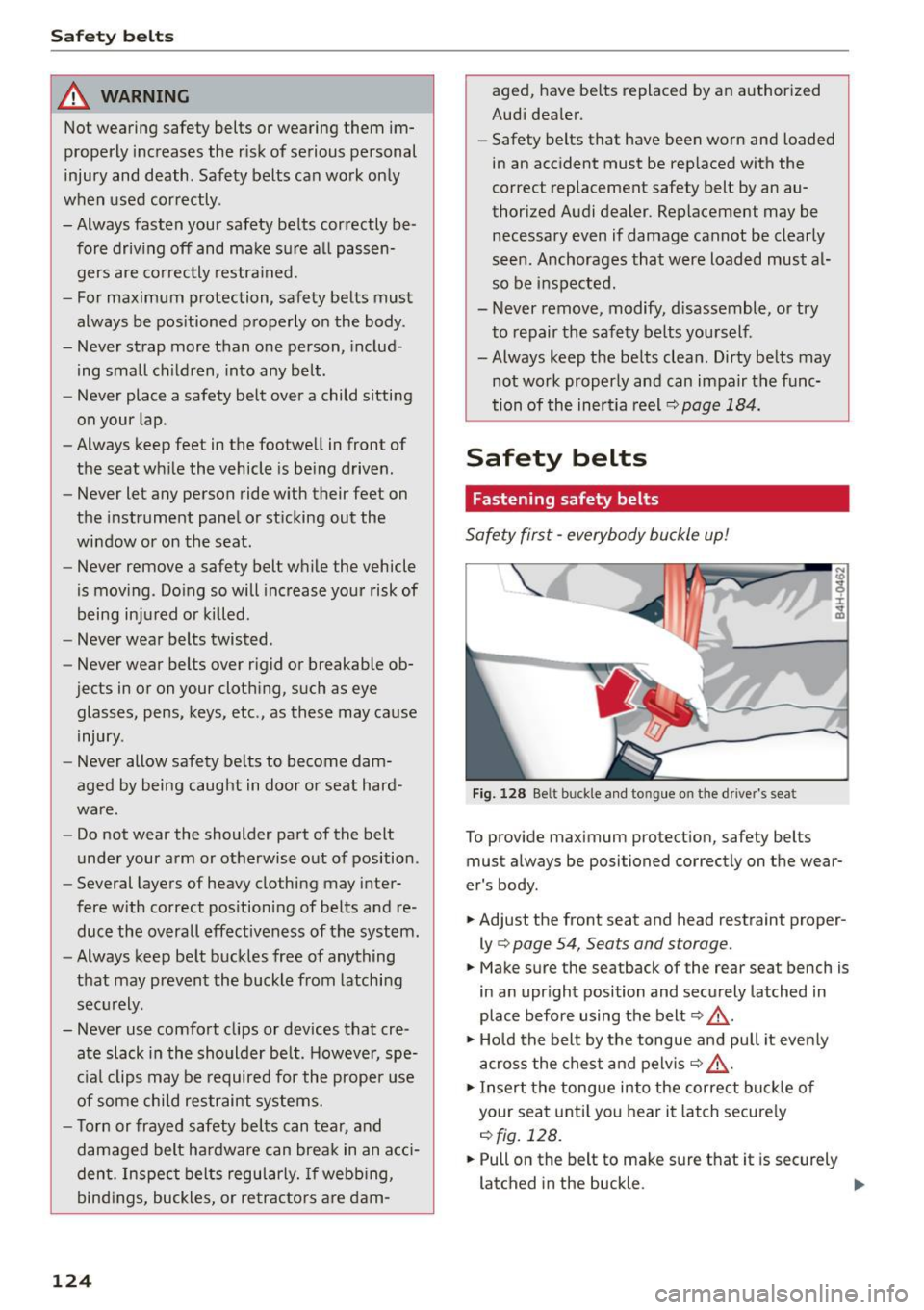
Safety belts
_& WARNING
Not wearing safety bel ts or wearing them im
properly increases the risk of serious personal
injury and death . Safety belts can work only
when used correctly .
- Always fasten your safety belts correctly be
fore driv ing off and make sure al l passen
gers are correctly restrained.
- For maximum protection, safety belts must
always be pos itioned properly on the body .
- Never strap more than one person, includ
ing small ch ild ren, into any belt .
- Never place a safety belt over a child sitting
on your lap .
- Always keep feet in the footwell in front of
the seat wh ile the vehicle is be ing driven .
- Never let any person ride with their feet on
the instrument panel or st icking out the
window or on the seat .
- Never
remove a safety belt while the vehicle
is moving . Doing so will increase your risk of
being in jured or killed .
- Never wear belts twisted .
- Never wear belts
over rigid or breakable ob-
jects in or on your cloth ing, such as eye
glasses, pens, keys, etc ., as these may cause
i njury .
- Never allow safety belts to become dam
aged by being caught in door or seat hard
ware.
- Do not wear the shoulder part of the belt
under your arm or otherwise out of position .
- Several layers of heavy clothing may inter
fere w ith correct pos itioning of belts and re
duce the overall effectiveness of the system.
- Always keep belt buckles free of anything
that may prevent the buckle from latching
securely .
- Never use comfort clips or devices that cre
ate slack in the shoulder belt. However, spe
c ial clips may be required for the proper use
of some child restraint systems.
- Torn or frayed safety belts can tear, and
damaged belt hardware can break in an acci
dent . Inspect belts regularly. If webb ing,
bind ings, buckles, or re tractors are dam-
124
aged, have belts replaced by an authorized
Audi dea ler.
- Safety belts that have been worn and loaded
in an accident must be rep laced with the
correct replacement safety belt by an au
thorized Audi dealer. Replacement may be necessary
even if damage cannot be clearly
seen . Anchorages that were loaded must al
so be inspected.
- Never
remove, modify, d isassemble, or try
to repair the safety belts yourself .
-Always keep the belts clean . Dirty belts may
not work properly and can impair the func
tion of the inert ia reel
¢ page 184.
Safety belts
Fastening safety belts
Safety first -everybody buckle up!
Fig. 128 Belt buckl e and to ngue o n th e dri ver's se at
To provide maximum protection, s afety belts
must a lways be positioned correctly on the wea r
er's body .
... Adjust the front seat and head restra int proper
ly ¢
page 54, Seats and storage.
... Make sure the seatback of the rear seat bench is
in an upr ight position and securely latched in
place before using the belt
q &_ .
.,. Hold the belt by the tongue and pull it even ly
across the chest and pelvis ¢ &_ .
.,. Insert the tongue into the correct buckle of
your seat unt il you hear it latch secure ly
¢ fig. 128.
... Pull on the belt to make sure that it is securely
latched in the buckle .
II>
Page 132 of 264
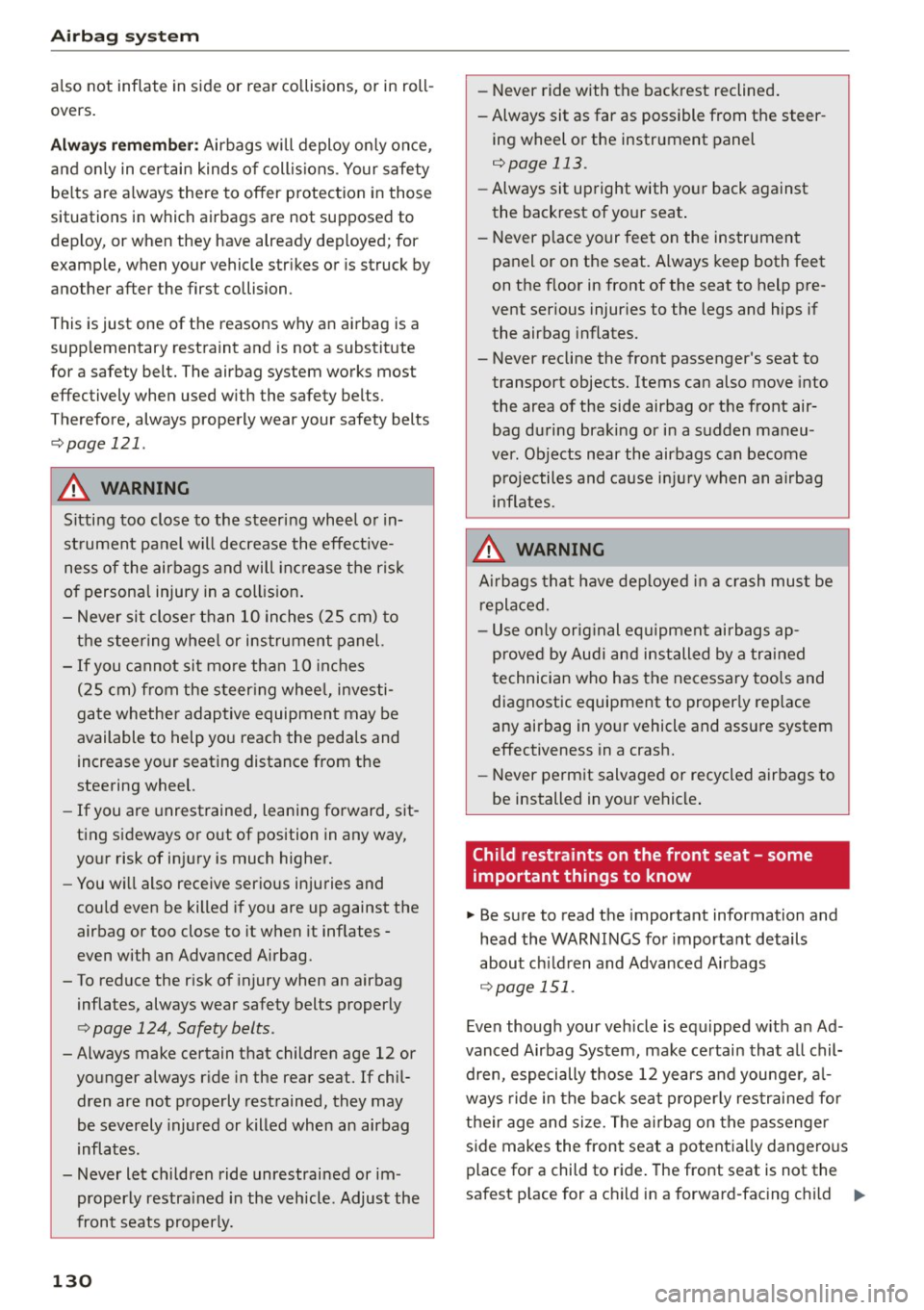
Airbag syste m
also not inflate in s ide or rear collisions, or in roll
overs.
Al wa ys rem ember : Airbags will deploy on ly once,
and only in certain kinds of collis ions . Your safety
be lts are a lways there to offer p rotection in those
situations in which airbags are not supposed to
deploy, or when they have already deployed; for
examp le, when your vehicle s trikes or is struck by
ano ther a fter the firs t collision .
This is just one of the reasons why an airbag is a
supp lementary restra int and is not a substitute
for a safety belt. The airbag system works mos t
e ff ectively when used w it h the safety belts.
Therefore, always properly wear your safety belts
r=;, page 121 .
A WARNING
Sitting too close to the steering wheel or in
strument panel wil l decrease the effect ive
ness of the airbags and will inc rease the risk
o f personal injury in a collision .
- Never sit closer than 10 inches (25 cm) to
the steering wheel or instrument panel.
- If you cannot sit more than 10 inches
( 2 5 cm) from the steer ing whee l, investi
gate whether adaptive equipment may be
available to help you reach the pedals and
increase yo ur seating distance from the
steering wheel.
- If you are unrestrained, leani ng forward, s it
ting sideways o r out of position in any way,
yo ur risk of in jury is much higher.
- You wi ll also receive serio us injuries and
could even be killed if you are up against the
airbag or too close to it when it inf lates -
even with an Advanced Airbag.
- To reduce the r isk of injury when an airbag
inflates, always wear safety belts properly
c> page 124, Safety belts .
- Always make certain that children age 12 or
younger always r ide in the rear seat. If chil
dren are not properly restrained, they may
be severely injured or killed when an airbag
inflates .
- Never let children ride unrestrained or im
properly restrained in the vehicle. Adjust the
front seats properly.
130
-
- Never ride with the backrest reclined .
- Always sit as far as possible from the steer -
ing wheel or the instrument panel
c> page 113.
-Always sit upright with yo ur back against
the backrest of yo ur seat .
- Never p lace your feet on the instrumen t
panel or on the seat. Always keep both feet
on the floor in front of the seat to help pre
vent serious injur ies to the legs and hips if
the airbag inflates.
- Never recline the front passenger 's seat to
transport objects. Items can also move into
the area of the side airbag o r the front air
bag during braking or in a sudden maneu
ver . Objects n ear the airbags can become
projectiles and cause in ju ry when an airbag
inflates.
A WARNING
A irbags that have deployed i n a crash mus t be
replaced.
- Use o nly orig inal equ ipmen t airbags ap
proved by Audi and installed by a trained
technician who has the necessary too ls and
diagnostic equipment to properly rep lace
any airbag in yo ur vehicle and assure system
effectiveness in a crash.
'
- Never permit salvaged or recycled airbags to
be installed in your vehicle .
Child restraints on the front seat - some
important things to know
""Be sure to read the importa nt information and
head the WARNINGS for importa nt details
about ch ild ren and Advanced Airbags
r=;, page 151 .
Even thoug h your veh icle is equipped w ith an Ad
vanced Airbag Sys tem, make ce rtain tha t all chil
dren, especially those 12 years and younge r, a l
ways ride in the ba ck seat p roperly res trained fo r
their age and size. The a irbag on the passenger
s ide makes the front seat a potent ially dangero us
place for a child to r id e. T he front seat is not the
safest p lace for a chi ld in a forward-fac ing chi ld ..,.
Page 135 of 264
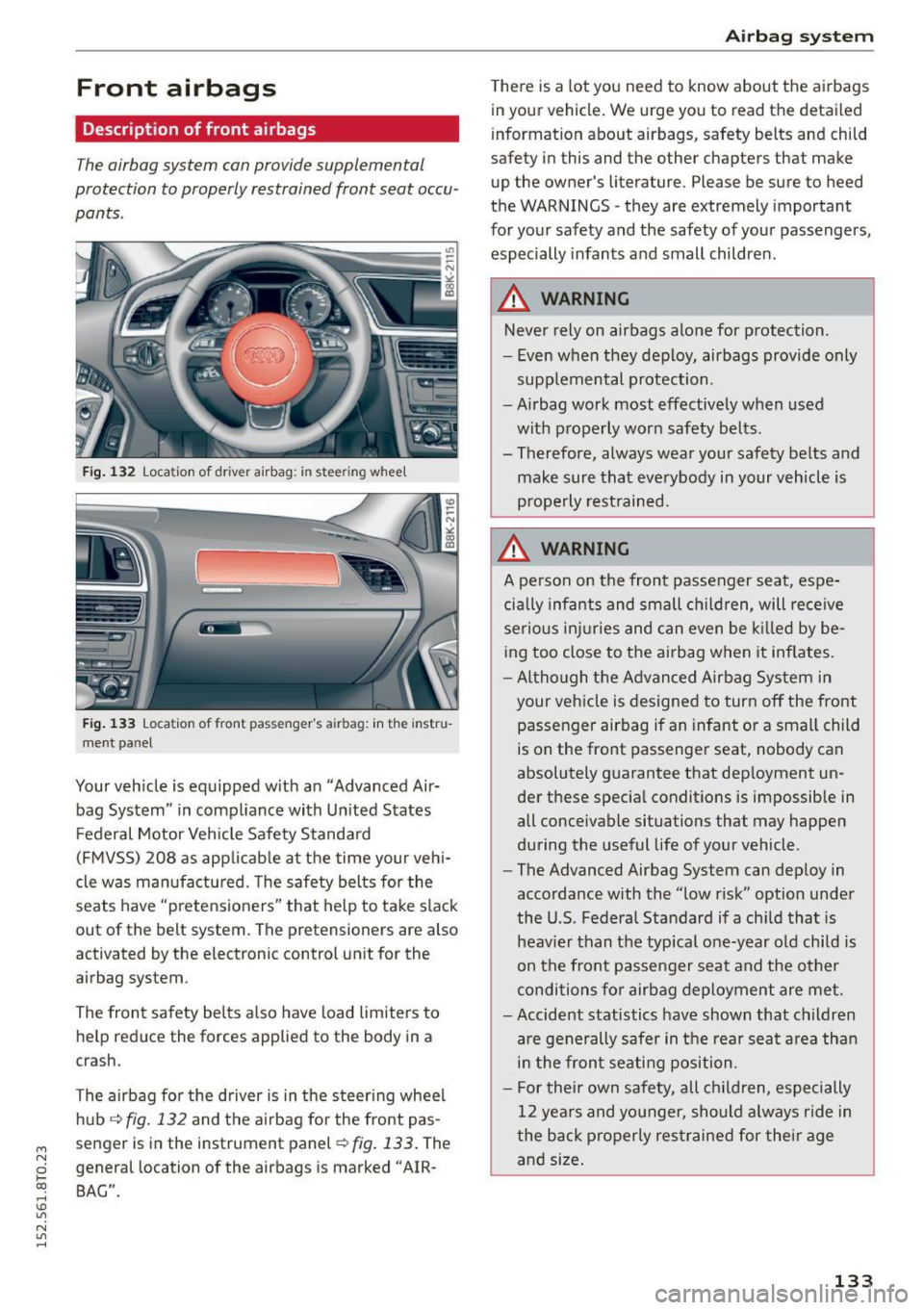
M N
0 loo
rl I.O
"' N
"' rl
Front airbags
Description of front airbags
The airbag system can provide supplemental
protection to properly restrained front seat occu
pants.
Fig . 132 Location of driver airbag: in steering wheel
Fig . 133 Location of front passenger's airbag: in the instru
ment panel
Your vehicle is equipped with an "Advanced Air
bag System" in compliance with United States
Federal Motor Vehicle Safety Standard
(FMVSS) 208 as applicable at the time your veh i
cle was manufactured. The safety belts for the
seats have "pretensioners" that help to take slack
out of the belt system. The pretensioners are also
activated by the electronic control unit for the
airbag system .
The front safety belts also have load limiters to he lp reduce the forces applied to the body in a
crash.
The airbag for the driver is in the steer ing wheel
hub
c::> fig . 132 and the airbag for the front pas
senger is in the instrument panel
~fig. 133. The
general location of the airbags is marked "AIR
BAG".
Ai rb ag system
There is a lot you need to know about the airbags
in your vehicle. We urge you to read the detailed
information about airbags, safety belts and child
safety in this and the other chapters that make
up the owner's literature. Please be sure to heed
the WARNINGS -they are extremely important
for your safety and the safety of your passengers, especially infants and small children.
_&. WARNING
Neve r rely on airbags alone for protection.
- Even when they deploy, airbags provide only
supp lemental protection.
- Airbag work most effectively when used
with properly worn safety belts.
- Therefore, always wear your safety belts and
make sure that everybody in your vehicle is properly rest rained.
_&. WARNING
--A pe rson on the front passenger seat, espe
cially infants and small ch ildren, will rece ive
se rious inj uries and can even be k illed by be
i ng too close to the airbag when it inflates.
- Altho ugh the Advanced Airbag System in
your veh icle is designed to turn off the front
passenger airbag if an infant or a small child
is on the front passenger seat, nobody can
absolutely guarantee that deployment un
der these special conditions is impossible in
all conceivable situations that may happen
during the useful life of your vehicle.
- The Advanced Airbag System can deploy in
accordance with the "low r isk" option under
the U.S. Federal Standard if a ch ild that is
heav ier than the typical one-year old child is
on the front passenger seat and the other
conditions for airbag deployment are met.
-Accident statistics have shown that children are generally safer in the rear seat area than
in the fron t seating position.
- For their own safety, all ch ildren, especially
12 years and yo unger, should a lways ride in
the back properly restrained for their age and size .
133
Page 136 of 264
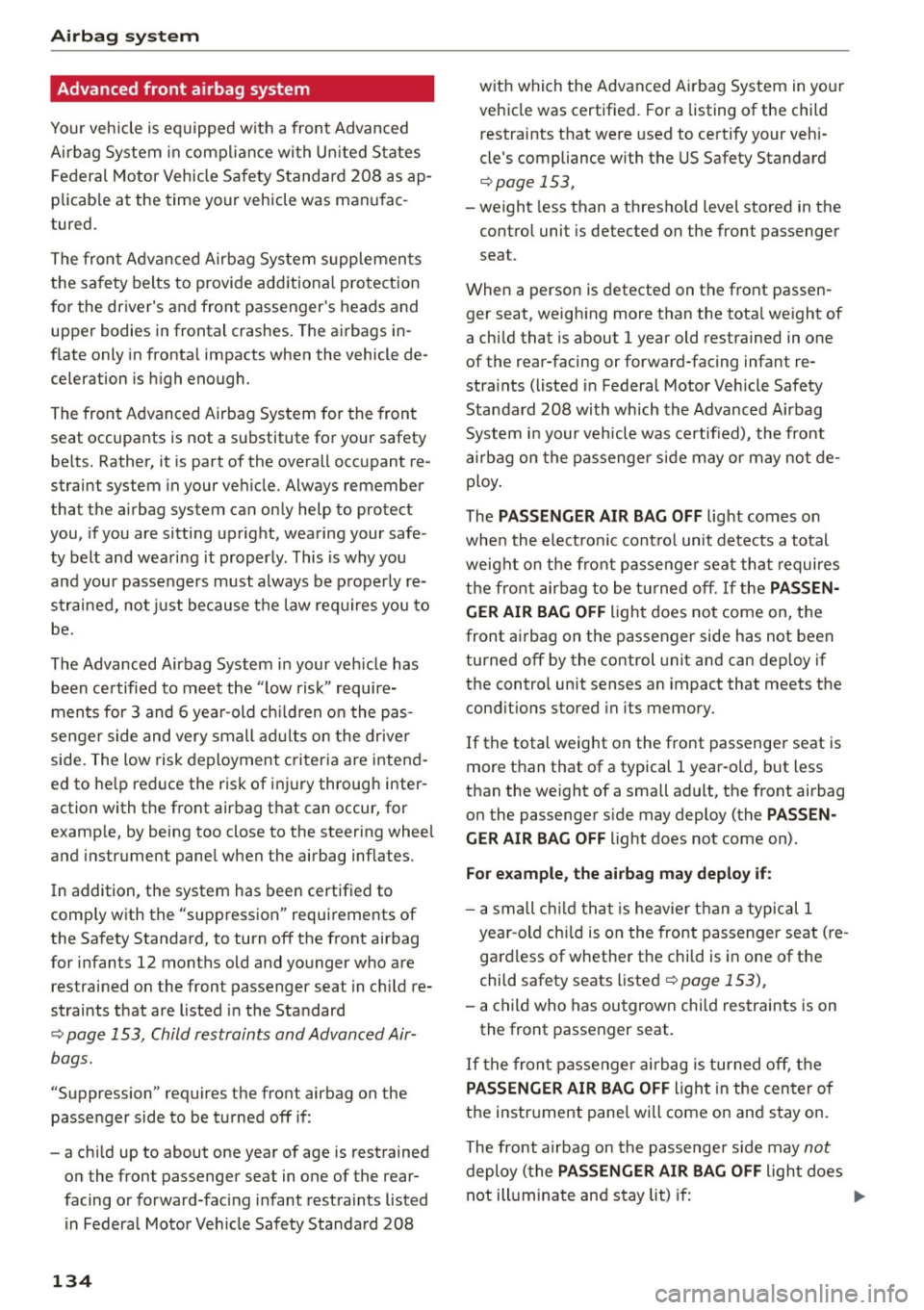
Airbag syste m
Advanced front airbag system
Your vehicle is equipped w ith a front Advanced
A irbag System in compl iance with Un ited States
F ederal Motor Vehicle Sa fety Standard 208 asap
plicab le at the time your vehicle was manu fac
tured .
The front Advanced Airbag System supplements
the safety belts to provide add itiona l protect ion
for the driver's and front passenger's heads and
upper bodies in frontal crashes. The airbags in
flate only in fronta l impacts when the vehicle de
celeration is high enough.
The front Advanced Airbag System for the front
seat occupants is not a substitute for your safety be lts. Rather, it is part of the overall occupant re
straint system in your veh icle. Always remember
that the airbag system can only help to protect
you, if you are sitting upright, wearing your safe
ty belt and weari ng it properly . This is why you
and your passengers must always be p roper ly re
strained, not just because the law requires you to
be.
The Advanced Airbag System in your veh icle has
been ce rtified to meet the "low risk" require
ments for 3 and 6 yea r-old ch ild ren o n the pas
senger side and very small ad ults on the drive r
side . The low risk deployment c riteria a re intend
ed to he lp red uce the risk of injury through inter
action with the front airbag t hat can occur, for
examp le, by being too close to the steering wheel
and instrument panel when the airbag inflates.
I n addition, the system has been certified to
comp ly with the "suppression" requirements of
the Safety Standard, to turn off the front airbag
for infants 12 months old and yo unger who are
restrained on the front passenger seat in ch ild re
straints that are listed in the Standard
c::> page 153, Child restraints and Advanced Air
bags.
"Suppression" requires the front airbag on the passenger side to be turned off if:
- a chi ld up to about one year of age is restrained
on the front passenger seat in one of the rear
facing or forward-fac ing infant restraints listed
i n Federa l Motor Veh icle Safety Standard 208
134 with which the Advanced Airbag System in you
r
vehicle was certified. For a listing of the child
restraints that were used to certify your vehi
cle 's compliance with the US Safety Standard
c::> page 153,
- weight less than a thresho ld level stored in the
control unit is detected on the front passenger
seat.
When a person is detected on the front passen
ger seat, weighing more than the tota l we ight of
a child that is about
1 year old restrained in one
of the rear-facing or forward-facing infant re
stra ints (listed in Federal Motor Vehicle Safety
Standard 208 with which the Advanced Airbag
System i n your vehicle was certified), the front
a irbag on the passenger s ide may or may not de
ploy.
The
PASSENGER AIR BAG OFF light comes on
whe n the elect ron ic cont ro l unit detects a total
weight on the fro nt passenger seat that requires
the front airbag to be tu rned off. If the
PASSEN
GER AIR BAG OFF
light does not come on, the
front airbag on the passenger side has not been
turned off by the control unit and can dep loy if
the control unit senses an impact that meets the cond it ions stored in its memory.
If the total weight on the front passenger seat is
more than that of a typical 1 year-o ld, but less
than the weight of a small adult, the front airbag
on the passenger s ide may deploy (the
PASSEN
GER AIR BAG O FF
light does not come on).
For ex ample , the air b ag ma y deplo y if:
-a small ch ild that is heavier than a typical 1
year -old chi ld is on the front passenger seat (re
gardless of whether the chi ld is in one of the
child safety seats listed
c::, page 153),
- a child who has outgrown chi ld restraints is on
the front passenger seat.
If the fron t passenger airbag is turned off, the
PASSENGER AIR BAG OFF light in the center of
the i nstr ument pane l will come on and stay on.
The front airbag on the passenger side may
not
deploy (the PASSENGER AIR BAG OFF light does
not ill uminate and stay lit) if: .,..
Page 138 of 264
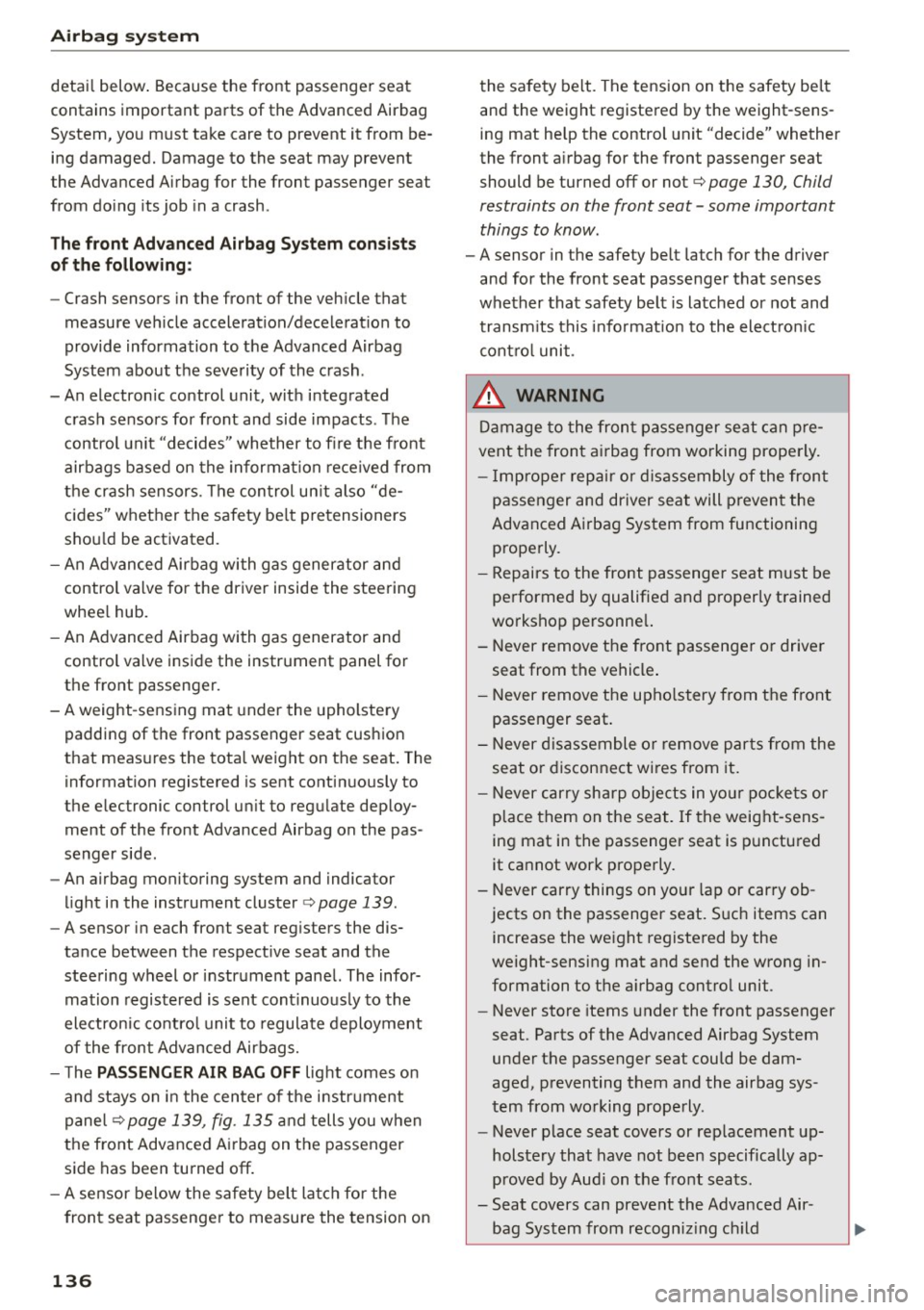
Airbag syste m
detail below . Because the front passenger seat
contains important parts of the Advanced Airbag
System, you must take care to prevent it from be ing damaged. Damage to the seat may prevent
the Advanced Airbag for the front passenger seat
from doing its job in a crash .
The front Ad vanced Airb ag System con sis ts
of the follow ing :
-Crash sensors in the front of the veh icle that
measure veh icle acceleration/decelerat ion to
provide information to the Advanced Airbag
System about the severity of the crash .
- An electronic control unit, with integrated crash sensors for front and side impacts. The
control un it "decides" whether to fire the front
airbags based on the informa tion rece ived from
the crash sensors. The con trol un it also "de
cides" whether the safety be lt pretensioners
shou ld be activated.
- An Advanced Airbag wi th gas generator and
control valve for the driver inside the steering
whee l hub.
- An Advanced Airbag with gas generator and
control va lve inside the instrument panel for
the front passenger.
- A weight -sensing mat under the upholste ry
padding of the front passenger seat cushion
that measures the total weight on the seat. The information registered is sent continuously to
the electronic control un it to regu late dep loy
ment of the front Advanced Airbag on the pas
senger side.
- An airbag monitoring system and indicator
light in the instrument cluster
r=> page 139.
-A sensor in each front seat registers the dis
tance between the respect ive seat and the
steering wheel or instrument panel. The infor
mation registered is sent cont inuously to the
electron ic co ntro l unit to regulate deployment
of the front Advanced Airbags.
- T he
PA SSENGER AIR B AG OFF light comes on
and stays on in the center of the instrument
pane l
c>page 139, fig . 135 and tells you when
the front Advanced A irbag on the passenger
side has been turned off.
- A sensor below the safety belt la tch for the
front seat passenge r to measure the tension on
136 the safety belt
. The tension on the safety be lt
and the weight registered by the weight-sens
ing mat help the control unit "decide" whether
the front a irbag for the front passenger seat
should be turned
off or not c> page 130, Child
restraints on the front seat -some important
things to know.
- A sensor in the safety belt latch for the driver
and for the front seat passenger that senses
whether that safety belt is latched or not and transm its this info rmat ion to the elect ro ni c
cont ro l unit .
_&. WARNING
Damage to the fron t passenger seat can pre
vent the front a irbag from working properly.
- I mproper repa ir or d isassembly of the front
passenger and driver seat will p revent the
Advanced Airbag System from functioning properly.
- Repairs to the front passenge r seat must be
performed by qualified and properly trained
wo rkshop personne l.
- Never remove the front passenger o r driver
seat from the vehicle .
- Never remove the upho lstery from the front
passenger seat.
- Never d isassemble o r remove par ts from the
seat or disconnect w ires from it.
- Never carry sharp obje cts in yo ur pocke ts or
place them on the seat. If the weight-sens
ing mat in the passenger seat is p unctured
it cannot work properly.
- Never carry things on you r lap or carry ob
jects on the passenger seat. S uch items can
increase the weight registe red by the
weight-sensing mat and send the wrong in formation to the airbag contro l unit.
- Never store items under the front passenger
seat. Parts of the Advanced Airbag System
under the passenger seat could be dam
aged, preventing them and the airbag sys
tem from wo rking prope rly.
- Never p lace seat covers or rep lacement up
holstery that have not been specifically ap
proved by Audi on the front seats.
- Seat covers can prevent the Advanced Air bag System from recogniz ing ch ild